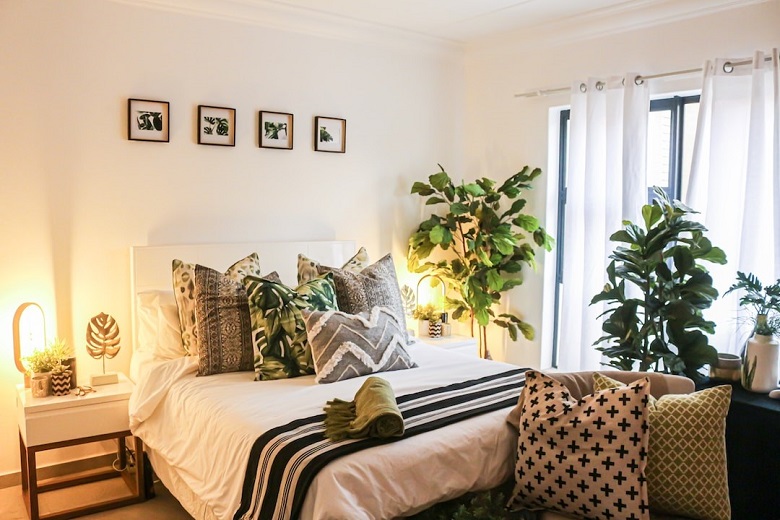Tips for Making a Bedroom Where You Can Relax

Spending time and effort in creating a bedroom where you can relax is immensely important for your peace and well-being. By designing a space that promotes better sleep, reduces stress, and improves your mental and physical health, you are creating a sanctuary that allows you to recharge and face the challenges of daily life with a renewed sense of energy and calmness. In this article, we’ll guide you through some expert tips to make your bedroom your favorite place to relax. If you’re in need of some advice or inspiration, keep reading!
Investing in High-Quality Bedding
The quality of your bedding enormously impacts your sleep quality and, therefore, your relaxation. Purchasing high-quality quilt bedding is a brilliant idea if you are seeking to create a relaxing bedroom ambiance. After a long and tiring day, there’s nothing better than sinking into a comfortable and inviting bed. Quilt bedding, specifically ones of superior quality, offers numerous benefits that contribute to a more peaceful and restful sleep experience. The combination of supreme comfort, optimal warmth, and appealing aesthetics contributes to a rejuvenating sleep experience that will leave you feeling refreshed and revitalized each morning.
The feel of your bedding also contributes to your relaxation experience. Different types of weaves provide different sleep experiences, and your choice should be based on personal preference. For a more luxurious feel, you could go for sateen woven sheets; if crisp and cool bedding is your liking, percale weave could be your perfect fit. Your goal is to create a bedroom that feels like a retreat, and every part of your bed contributes to that effect.
Choosing the Perfect Color Palette
The color palette is the backbone of your room’s design. It affects the atmosphere and your mood. Experts suggest going for soothing and relaxing tones like blues, greens, or pastels. These colors are known to lower stress levels and promote relaxation. When choosing the color palette for your room, consider the kind of ambiance you want to create. Subdued tones and soft hues can provide a calming effect, making your bedroom a perfect place to relax.
Choosing the right color palette is integral to achieving a balanced design. Consistency in your color palette will give your room a cohesive look while contrasting colors can add a vibrant touch to your space. Consider adding accent tones that match the dominant color of your bedding. This way, you can create a room that’s visually pleasing and calming at the same time. Choosing the perfect color palette doesn’t mean limiting yourself to one or two colors. The key is to create a harmonious blend of colors that will provide a calming effect.
Making Use of Natural Light
Natural light plays a vital role in creating a relaxing bedroom atmosphere. It illuminates the room in a way that no artificial light can. Natural light is known to improve mood, boost productivity, and regulate sleep patterns. By utilizing natural light, you can noticeably enhance your comfort level in your bedroom. It’s advisable to keep your window treatments minimal to let as much light in as possible.
Managing the amount of natural light that enters your space is crucial. Too much light can elevate the room’s temperature, which can affect your comfort level. You can use adjustable blinds or drapes to control the light intensity throughout the day. Mirrors can also be used strategically to reflect natural light and make your room appear more spacious and brighter. Understanding how sunlight changes in your bedroom throughout the day can maximize natural light without letting it overpower your space.
Strategically Placing the Furniture
How you arrange your furniture can heavily impact the serenity of your bedroom. Avoid positioning your bed directly against the window or door since it will disrupt the pathway of natural light. Placing progressively smaller furniture pieces from your bed (such as a bedside table or standing lamp) creates depth in the room and makes it look bigger. Additionally, don’t overcrowd your space. Keeping your room clutter-free adds to its tranquility.
Adequate storage is another factor to consider to keep your bedroom neat. Storing clothes and personal items properly will provide a sense of order and calmness. Modern furniture designs now come with built-in storage spaces that will help you keep your items organized without sacrificing style. Ensure your bedroom furniture reflects your personality. From choosing a bed frame design to getting the perfect dressing table, every furniture piece should speak to your style and aesthetic. Your bedroom is an extension of you, and having furniture that you love will make it truly relaxing.
Incorporating Natural Elements and Greenery
Bringing nature indoors can improve relaxation in your bedroom. Houseplants project calming energy and some can purify the air. Choose low-maintenance plants like snake plants or golden pothos if you’re a novice in gardening. Indoor plants can make your room feel alive and fresh, fostering a peaceful ambiance. Besides houseplants, other natural elements like wooden furniture or a woven basket can also boost the aura of the room.
Natural elements bring softness and warmth, creating an intimate and cozy atmosphere. While picking these items, remember to stick to your chosen aesthetic theme to maintain the room’s appeal. The presence of water can create a sense of tranquility too. A small indoor fountain or an aquarium can lend your bedroom the soothing sound of flowing water. However, they require regular maintenance, so consider this before making a selection.
Focusing On Room Scents
Aromas can significantly affect our mood. Some scents like lavender, chamomile, and mandarin are renowned for their calming properties. You can opt for scented candles, diffusers, or essential oils to infuse your bedroom with these relaxing scents. Choose a fragrance that you love, and that induces peace and relaxation. Keep in mind that less is often more when it comes to room fragrances. An overpowering scent can become distracting over time instead of promoting relaxation.
Opt for subtle, soothing fragrances that gently perfume your room to create a calming environment for relaxation and good sleep. You may also want to try rotating your room fragrances. With time, your olfactory senses may get accustomed to a particular scent, rendering it less effective. Changing up your room scent every once in a while will keep your space smelling fresh and new, thus contributing to its relaxing appeal.
Paying Attention to Art and Decor
Art and decor add the finishing touches to your bedroom design. Like furnishings, the pieces you choose should reflect your personal style and contribute to the room’s overall serene atmosphere. You might prefer minimalist wall art, a sophisticated sculpture, or a family photo gallery. Remember, your wall art and decor should evoke positive emotions and add to the relaxed vibe of your space. No matter what decor you need, be sure to buy it from a retailer that customers love and trust.
Adding texture and layering to your decor can enhance the comfort and coziness of your bedroom. The more texture and layering, the more intimate and inviting your space will feel. Lighting fixtures are a major part of the decor as well. For a relaxing bedroom, it’s good to have dimmable lights or lamps with softer tones. Harsh white lights may interfere with your sleep. Instead, think about installing a bedside lamp for reading before sleep or a warm-toned overhead light to create a cozy ambiance at night.
As this article demonstrates, creating a relaxing bedroom involves focusing not only on aesthetics but also on functional details – natural light, quality bedding, and soothing fragrances. With all these elements in harmony, your bedroom will surely become your relaxation haven. This is a home improvement project that you will definitely appreciate and enjoy for years to come. Follow our expert tips and you’ll be well on your way to designing the bedroom of your dreams.











